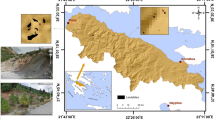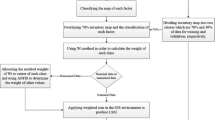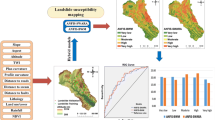Abstract
Landslides susceptibility maps were constructed in Seorak mountain area, Korea, using an integration of frequency ratio and adaptive neuro-fuzzy inference system (ANFIS) in geographical information system (GIS) environment. Landslide occurrence areas were detected in the study by interpreting aerial photographs and field survey data. Landslide locations were randomly selected in a 50/50 ratio for training and validation of the models, respectively. Topography, geology, soil, and forest databases were also constructed. Maps relevant to landslide occurrence were assembled in a spatial database. Using the constructed spatial database, 17 landslide-related factors were extracted. The adaptive ANFIS model with different types of membership functions (MFs) was then applied for landslide susceptibility mapping in the study area. Two landslide susceptibility maps were prepared using the different MFs. The frequency ratio model was also applied to the landslide susceptibility mapping for comparing with the probabilistic ANFIS model. Finally, the resulting landslide susceptibility maps were validated using the landslide locations which were not used for training the ANFIS. The validation results showed 75.57 % accuracy using the generalized bell-shaped MF model, 74.94 % accuracy using the Sigmoidal 2 MF model and 73.07 % accuracy using frequency ratio model. These accuracy results show that an ANFIS can be an effective tool in landslide susceptibility mapping.









Similar content being viewed by others
References
Althuwaynee OF, Pradhan B, Lee S (2012) Application of an evidential belief function model in landslide susceptibility mapping. Comput Geosci 44:120–135
Bai S, Lü G, Wang J, Zhou P, Ding L (2011) GIS-based rare events logistic regression for landslide-susceptibility mapping of Lianyungang, China. Environ Earth Sci 62(1):139–149
Bai S, Wang J, Zhang Z, Cheng C (2012) Combined landslide susceptibility mapping after Wenchuan earthquake at the Zhouqu segment in the Bailongjiang Basin, China. Catena 99:18–25
Bateni SM, Borghei SM, Jeng DS (2007) Neural network and neuro-fuzzy assessments for scour depth around bridge piers. Eng Appl Artif Intel 20(3):401–414
Beven KJ, Kirkby MJ (1979) Physically based, variable contributing area model of basin hydrology. Hydrolog Sci J 24:43–69
Cohen J (1960) A coefficient of agreement for nominal scales. Educ Psychol Meas 20:37–46
Cowen J (1993) A proposed method for calculating the LS factor for use with the USLE in a grid-based environment: Proceedings of the thirteenth annual ESRI user conference, p 65–74
Dai FC, Lee CF (2002) Landslide characteristics and slope instability modeling using GIS, Lantau Island, Hong Kong. Geomorphology 42:213–228
Desmet P, Grovers G (1996) A GIS procedure for automatically calculating the USLE LS factor on topographically complex landscape units. J Soil Water Conserv 51(5):427–433
Devkota KC, Regmi AD, Pourghasemi HR, Yoshida K, Pradhan B, Ryu IC, Dhital MR, Althuwaynee OF (2013) Landslide susceptibility mapping using certainty factor, index of entropy and logistic regression models in GIS and their comparison at Mugling–Narayanghat road section in Nepal Himalaya. Nat Hazard 65(1):135–165
Dhakal AS, Sidle RC (2003) Long-term modeling of landslides for different forest management practices. Earth Surf Proc Land 28:853–868
Dixon B (2005) Applicability of neuro-fuzzy techniques in predicting ground-water vulnerability: a GIS-based sensitivity analysis. J Hydrol 309(1–4):17–38
Edeso JM, Merino A, González MJ, Marauri P (1999) Soil erosion under different harvesting managements in steep forest lands from northern Spain. Land Degrad Dev 10:79–88
Feizizadeh B, Blaschke T, Nazmfar H (2012) GIS-based ordered weighted averaging and Dempster-Shafer methods for landslide susceptibility mapping in the Urmia Lake Basin, Iran. Int J Digit Earth. doi:10.1080/17538947.2012.749950
Güler I, Übeyli ED (2005) Adaptive neuro-fuzzy inference system for classification of EEG signals using wavelet coefficients. J Neurosci Meth 148:113–121
Hickey R (1994) Design and simulation of smelter reclamation strategies using an environmental decisions support system. Doctoral Dissertation. Department of Geography, University of Idaho
Hickey R (2000) Slope Angle and Slope Length Solutions for GIS. J Cartogr 29(1):1–8
Jang JSR (1993) ANFIS: adaptive-network-based fuzzy inference system. IEEE T Syst Man Cyb 23(3):665–685
Jang JSR, Sun CT (1995) Neuro-fuzzy modeling and control. P IEEE 83(3):378–406
Landis JR, Koch GG (1977) The measurement of observer agreement for categorical data. Biometrics 33:159–174
Lee S (2007) Comparison of landslide susceptibility maps generated through multiple logistic regression for three test areas in Korea. Earth Surf Proc Land 32(14):2133–2214
Lee S, Dan NT (2005) Probabilistic landslide susceptibility mapping in the Lai Chau province of Vietnam: focus on the relationship between tectonic fractures and landslides. Environ Geol 48(6):778–787
Lee S, Min K (2001) Statistical analysis of landslide susceptibility at Yongin, Korea. Environ Geol 40:1095–1113
Lee S, Sambath T (2006) Landslide susceptibility mapping in the Damrei Romel area, Cambodia using frequency ratio and logistic regression models. Environ Geol 50:847–855
Lee MJ, Choi JW, Oh HJ, Won JS, Park I, Lee S (2012) Ensemble-based landslide susceptibility maps in Jinbu area, Korea. Environ Earth Sci 67(1):23–37
Lee S, Hwang J, Park I (2013) Application of data-driven evidential belief functions to landslide susceptibility mapping in Jinbu, Korea. Catena 100:15–30
Lepore C, Kamal SA, Shanahan P, Bras RL (2012) Rainfall-induced landslide susceptibility zonation of Puerto Rico. Environ Earth Sci 66(6):1667–1681
Li Y, Chen G, Tang C, Zhou G, Zheng L (2012) Rainfall and earthquake-induced landslide susceptibility assessment using GIS and Artificial Neural Network. Nat Hazard Earth Syst Sci 12(8):2719–2729
Mitasova H, Hofierka J, Zlocha M, Iverson L (1996) Modelling topographic potential for erosion and deposition using GIS. Int J GIS 10(5):629–641
Moore ID, Grayson RB, Ladson AR (1991) Digital terrain modelling: a review of hydrological, geomorphological, and biological applications. Hydrol Proc 5:3–30
Mousavi SJ, Ponnambalam K, Karray F (2007) Inferring operating rules for reservoir operations using fuzzy regression and ANFIS. Fuzzy Set Syst 158(10):1064–1082
Nauck D, Kruse R (1998) A neuro-fuzzy approach to obtain interpretable fuzzy systems for function approximation. Fuzzy Systems Proceedings, 1998. IEEE World Congress on Computational Intelligence. The 1998 IEEE International Conference on 2: 1106–1111
Neuhäuser B, Damm B, Terhorst B (2012) GIS-based assessment of landslide susceptibility on the base of the Weights-of-Evidence model. Landslides 9(4):511–528
Oh HJ, Pradhan B (2011) Application of a neuro-fuzzy model to landslide-susceptibility mapping for shallow landslides in a tropical hilly area. Comput Geosci 37(9):1264–1276
Oh HJ, Ahn SC, Choi JK, Lee S (2011) Sensitivity analysis for the GIS-based mapping of the ground subsidence hazard near abandoned underground coal mines, Environmental Earth Science, Article in press, doi:10.1007/s12665-010-0855-1
Oh HJ, Park NW, Lee SS, Lee S (2012) Extraction of landslide-related factors from ASTER imagery and its application to landslide susceptibility mapping. Int J Remote Sens 33(10):3211–3231
Park I, Choi J, Lee MJ, Lee S (2012) Application of an adaptive neuro-fuzzy inference system to ground subsidence hazard mapping. Comput Geosci 48:228–238
Pradhan B (2013) A comparative study on the predictive ability of the decision tree, support vector machine and neuro-fuzzy models in landslide susceptibility mapping using GIS. Comput Geosci 51:350–365
Pradhan B, Mansor S, Pirasteh S, Buchroithner MF (2011) Landslide hazard and risk analyses at a landslide prone catchment area using statistical based geospatial model. Int J Remote Sens 32(14):4075–4087
Ramakrishnan D, Singh TN, Verma AK, Gulati A, Tiwari KC (2013) Soft computing and GIS for landslide susceptibility assessment in Tawaghat area, Kumaon Himalaya, India. Nat Hazard 65(1):315–330
Saito H, Nakayama D, Matsuyama H (2009) Comparison of landslide susceptibility based on a decision-tree model and actual landslide occurrence: the Akaishi Mountains, Japan. Geomorphology 109:108–121
Sarkar S, Kanungo DP (2004) An integrated approach for landslide susceptibility mapping using remote sensing and GIS. Photogramm Eng Remote Sens 70:617–625
Schicker R, Moon V (2012) Comparison of bivariate and multivariate statistical approaches in landslide susceptibility mapping at a regional scale. Geomorphology 161–162:40–57
Sim J, Wright CC (2005) The kappa statistic in reliability studies: use, interpretation, and sample size requirements. Phys Ther 85:257–268
Sterlacchini S, Ballabio C, Blahut J, Masetti M, Sorichetta A (2011) Spatial agreement of predicted patterns in landslide susceptibility maps. Geomorphology 125:51–61
Sugeno M (1985) An industrial applications of fuzzy control. Inform Sci 36:59–83
Suh J, Choi Y, Roh TD, Lee HJ, Park HD (2011) National-scale assessment of landslide susceptibility to rank the vulnerability to failure of rock-cut slopes along expressways in Korea. Environ Earth Sci 63(3):619–632
Tien Bui D, Pradhan B, Lofman O, Revhaug I, Dick OB (2013) Regional prediction of landslide hazard using probability analysis of intense rainfall in the Hoa Binh province, Vietnam. Natl Hazard 66(2):707–730
Wan S, Lei TC, Chou TY (2010) A novel data mining technique of analysis and classification for landslide problems. Nat Hazard 52(1):211–230
Wang YM, Elhag TMS (2008) An adaptive neuro-fuzzy inference system for bridge risk assessment. Expert Syst Appl 34:3099–3106
Wischmeier WH, Smith DD (1978) Predicting rainfall erosion losses-A guide to conservation planning: agricultural handbook, vol 537. Science and Education Administration., US Department of Agriculture, Washington, D. C
Xu C, Dai F, Xu X, Lee YH (2012a) GIS-based support vector machine modeling of earthquake-triggered landslide susceptibility in the Jianjiang River watershed, China. Geomorphology 145–146:70–80
Xu C, Xu X, Dai F, Saraf AK (2012b) Comparison of different models for susceptibility mapping of earthquake triggered landslides related with the 2008 Wenchuan earthquake in China. Comput Geosci 46:317–329
Yalcin A, Reis S, Aydinoglu AC, Yomralioglu T (2011) A GIS-based comparative study of frequency ratio, analytical hierarchy process, bivariate statistics and logistics regression methods for landslide susceptibility mapping in Trabzon, NE Turkey. Catena 85(3):274–287
Yilmaz I (2010) Comparison of landslide susceptibility mapping methodologies for Koyulhisar, Turkey: conditional probability, logistic regression, artificial neural networks, and support vector machine. Environ Earth Sci 61(4):821–836
Acknowledgments
This research was supported by the Basic Research Project of the Korea Institute of Geoscience and Mineral Resources (KIGAM) funded by the Ministry of Science, ICT and Future Planning, and Korea Environmental Institute (KEI) funded by the Development Project of Environmental Technology for Climate Change by the Korea Environmental Industry and Technology Institute.
Author information
Authors and Affiliations
Corresponding author
Rights and permissions
About this article
Cite this article
Lee, MJ., Park, I. & Lee, S. Forecasting and validation of landslide susceptibility using an integration of frequency ratio and neuro-fuzzy models: a case study of Seorak mountain area in Korea. Environ Earth Sci 74, 413–429 (2015). https://doi.org/10.1007/s12665-015-4048-9
Received:
Accepted:
Published:
Issue Date:
DOI: https://doi.org/10.1007/s12665-015-4048-9




